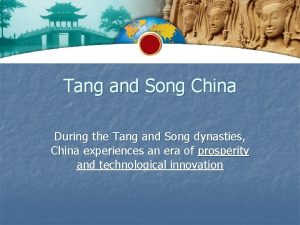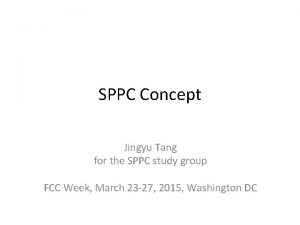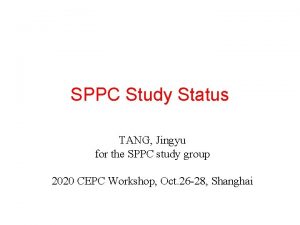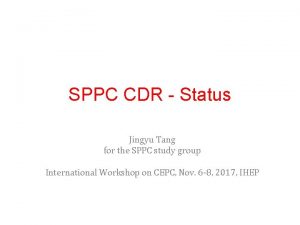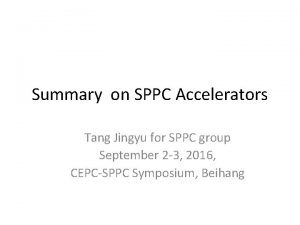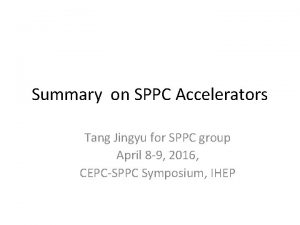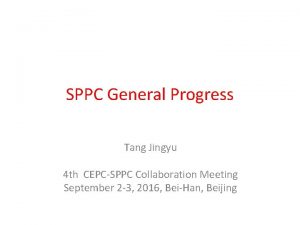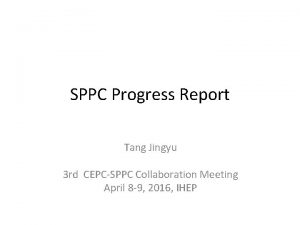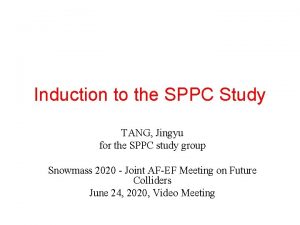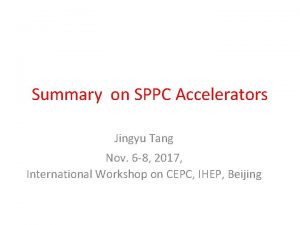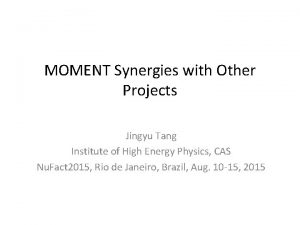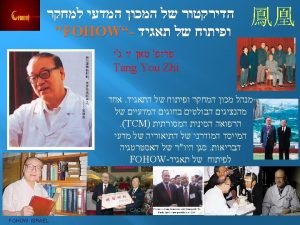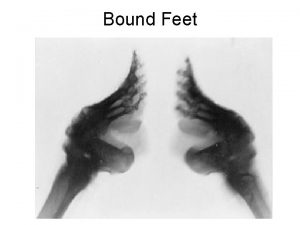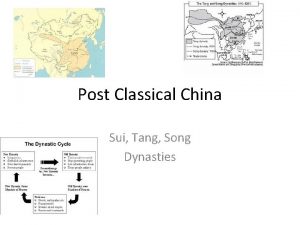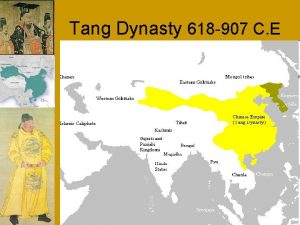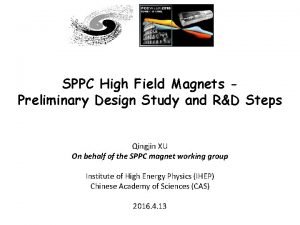SPPC Progress Jingyu Tang for the SPPC study






















- Slides: 22

SPPC Progress Jingyu Tang for the SPPC study group FCC Week, April 11 -15, 2016, Rome, Italy

Main topics • • • Brief about CEPC-SPPC Layout consideration Main features on accelerator physics Injector chain Technical challenges and R&D requirements Summary 2

CEPC-SPPC is a two-stage project, with CEPC of 240 -Ge. V electron-positron collider for high-precision Higgs studies, and SPPC of >70 Te. V proton-proton collider for studying new physics beyond the Standard Model. e+ e- IP 1 LTB SPPC HE Booster SPP ME Booster BTC e+ e. Linac SPPC LE Booster Proton Linac IP 2 IP 4 CE PC Bo ost er ~54 km in circumference ing IP 3 SPPC Collider Ring CE PC R der i l l o C 3

From CEPC to SPPC • SPPC is the second phase of the project, differing by 10 -15 years • Use the same CEPC tunnel to build SPPC, exploring new physics beyond SM • Maximize the beam energy to 70 -100 Te. V range by using 20 -T SC magnets (or 16 T for a larger ring) • Keep the e-rings when adding the SPPC (not the detectors) • Collisions possible: pp, e-/e+, ep, e. A, AA • Build a new injector chain for SPPC (proton and ions) • Independent physics programs for the accelerators of the injector chain 4

SPPC main parameters Parameter Circumference C. M. energy Dipole field Injection energy Number of IPs Peak luminosity per IP Beta function at collision Circulating beam current Bunch separation Bunch population SR heat load @arc dipole (per aperture) Value 54. 36 70. 6 20 2. 1 2 1. 2 E+35 0. 75 1. 0 25 2. 0 E+11 56. 9 Unit km Te. V T Te. V cm-2 s-1 m A ns W/m (80 -100 km tunnel, 100 Te. V is also under study) 5

General layout SPPC rings: • 8 arcs (5. 9 km) and long straight sections • 1 longer LSS collimation (ee detector) • 1 longer LSS for extraction (ee detector) • 2 LSSs for pp detectors • 2 LSSs for AA or ep detector • 2 LSSs for RF and injection 6

Considerations on the layout and lattice • Lattice: design under way – 8 arcs and long straight sections (accepted by CEPC) – Race-track layout of two very long straight sections for collimation and extraction, which is compatible to the CEPC partial double-ring – Arcs will be traditional FODO based, 6 -8 long SC dipoles per half cell, full-bend for dispersion suppression – Other long straight sections are important for detectors (pp, AA and ep), RF stations, injection and extraction • Strong focusing by SC triplets at IPs (L*>35 m) • Beam separation/recombination from nominal one at arcs 7

Main features on accelerator physics • Very high luminosity: 1. 2 1035 cm-2 s-1 – Supported by powerful injector chain and strong focusing at IPs – Integrated luminosity enhancement by exploring emittance damping (luminosity leveling) • Very high synchrotron radiation power: 56 W/m @dipole – High circulation current: 1 A (similar to HL-LHC) • Machine protection by sophisticated collimation system /abort system (6. 6 GJ per beam; inefficiency: 10 -6) • Instability issues – Electron cloud, resistive wall (beam screen, collimators) etc. • Challenges in lattice design – Insertion lattice (IP, collimation, extraction, injection) – Compatible with the CEPC rings 8

• Synchrotron radiation is a key issue in the machine – With 35 Te. V and 20 T, about 57 W/m per aperture at arc dipoles, totaling 2. 1 MW per beam – Big problems for the vacuum and cryogenics (heat load), really challenging to solve the problem – Tentative solutions: beam screen (to be discussed later), open mid-plane dipoles – Benefit: emittance shrinking (suppressing instabilities, increasing integrated luminosity) • Beam-beam effects – Different effects: incoherent tune shift, PACMAN effect, coherent effect – Nominal B-B tune shift set to conservative 0. 012, but may increased according to simulations and machine studies – May be increased during the burn-up process of beam by controlling emittance heat-up – Remedy by electron lens 9

• Luminosity leveling: Increasing the average luminosity by programing the beam collision scenario (controlled emittance shrinking, turnaround time, beta*, B-B parameter) 10

• Electron cloud effects – Electron cloud effects are considered critical in high-luminosity colliders, including SPPC: coupled bunch instability etc. – Measures must be taken for suppressing: special coating to have a small SEY (<1. 2), beam-screen structure, etc. • Beam loss and machine protection – Sources of beam losses: malfunctioned injection and acceleration, burn-up and scattering at collision, nonlinear dynamics effect, collective instability effects (ECI, resistive wall etc. ), beam-gas interaction etc. – Stored energy in beam is as high as 6. 6 GJ, beam trips and beam losses are big concerns for the safe operation of the machine [up to a few MW beam power loss during collision] – Highly efficient collimation system and reliable beam abort system 11

• Collimation method – Collimation: must beam very efficient, e. g. inefficiency 10 -6 (vs 10 -5 at LHC/14 -Te. V), to prevent significant beam loss at arcs, and reduce loss rate at detectors – Collimation efficiency decreases with increasing energy, more sophisticated design is needed – A four-stage collimation method (similar at LHC, or one more stage ) is considered for both transverse and longitudinal collimation 12

– LHC collimation problem: large beam loss at the DS section, due “Single-diffractive (SD) effect“ downstream of IR 7 (trans. Coll. ), – SD effect becomes even more important at higher energy – Solution: Trans. and long. collimation in a same LSS – Consider use of SC quads (lower field, large apertures with shielding) to increase phase advance – Material also be an important issue: contribution to impedance, needing new type materials – Novel collimation methods under consideration: bent crystal, electron lens, nonlinear magnets etc. 13

• Injection – Injection by bunch batches from Super Synchrotron, 6 fills – Two injections in the same IR (betatron match sections) – According to HERA, Tevatron and LHC, injection process quite complicated (pilot beam tests) – Touraround time: ~3 hrs (min. 0. 8 hrs), compared to 5 -10 hrs collision time • Extraction/abort – Very important for safe machine operation: huge energy stored in beams, only allowed to dump into a specially designed dump station with diluted beam spot – Needed: abnormal beam injection and acceleration; early termination collision and beam remains before refill – Reliability and low beam loss are key issues (kickers, septa) – Gaps between bunch trains needed for injection and extraction (PACMAN effect, helpful for ECI) 14

Injector chain (for proton beam) p-Linac: proton superconducting linac p-RCS: proton rapid cycling synchrotron MSS: Medium-Stage Synchrotron SS: Super Synchrotron Ion beams have dedicated linac (I-Linac) and RCS (I-RCS) 15

Major parameters for the injector chain Value p-Linac Energy Average current Length RF frequency Repetition rate Beam power p-RCS Energy Average current Circumference RF frequency Repetition rate Beam power Unit 1. 2 1. 4 ~300 325/650 50 1. 6 Ge. V m. A m MHz Hz MW 10 0. 34 900 36 -40 25 3. 4 Ge. V m. A m MHz Hz MW MSS Energy Average current Circumference RF frequency Repetition rate Beam power SS Energy Accum. protons Circumference RF frequency Repetition period Protons per bunch Dipole field Value Unit 180 20 3500 40 0. 5 3. 7 Ge. V u. A m MHz Hz MW 2. 1 2. 55 E 14 7000 200 30 2. 0 E 11 8 Te. V m MHz s T 16

More about the Injector Chain • Injector chain by itself is a very complicated and powerful accelerator system, large enough by a single stage – Totally new, different from LHC or Tevatron (building-up by steps) – No close reference accelerators (scaled up by large factors) – Should be built earlier than SPPC by a few years to allow relatively long-time commissioning stage by stage • Rich physics programs for each stage, e. g. : – p-Linac: producing intense neutrons and muons and rare isotopes for wide research areas – p-RCS and MSS: producing very powerful neutrino beams for neutrino oscillation experiments • Design work started: schemes, lattices, … • Key technical challenges should be identified, so needed R&D program can be pursued

Technical challenges and R&D requirements -High field SC magnets • SC dipoles of 20 T are key both in technical challenges and machine cost 2/3 ring circumference Nb 3 Sn (15 T) +HTS (5 T) or pure HTS Twin-aperture: save space and cost Common coils or Cosine-theta type Open mid-plane structure to solve SR problem? – SC quads: less number but also difficult Beam pipes: 2 * Φ 50 mm – – – • Domestic and intern. collaboration very important Load line ratio: ~80% @ 1. 9 K Yoke diameter: 800 mm Q. J. Xu’s talk on Wed. 18

Beam screen and vacuum • Beam screen: key issue to solve the problem with very high synchrotron radiation power inside cryogenic vacuum. – Need to develop an effective structure and working temperature to guide out the high heat load when minimizing SEY, heat leakage to cold mass, impedance in the fast ramping field, vacuum instability etc. – Both design and R&D efforts needed to solve this critical problem. • New ideas emerge out (FCC), SPPC is also investigating feasible structures and coating methods L: FCC ideas R: study at SPPC 19

Other important technical challenges • Collimation system: new materials to reduce impedance and tolerate more heat deposit • Very large scale cryogenics system: SC magnets, SRF, beam screens • Sophisticated beam feedback system: to control the emittance heat-up and suppress beam instabilities • Machine protection system: fast detection of abnormal function, reliable beam abort (kickers and septa) • There also many technical challenges in building highpower injector chain: e. g. RF systems for p-RCS and MSS, fast ramping for SS 20

Summary • SPPC - the second phase of CEPC-SPPC, a schematic design for a >70 -Te. V pp collider is being studied, to explore new physics in energy frontier • SPPC will provide wide physics programs, including the collider and the beams from the injector accelerators • Technical challenges to be solved in the next two decades, in particular, high-field SC magnets and beam screen • Some progresses have been made, with a goal of preconceptual design integrated in the CEPC-SPPC CDR • It is very important to have wide collaboration with international labs, and unification of domestic resources • Suggestions and participation in study are much welcome 21

Thanks for your attention! 22
 Song dynasty rulers
Song dynasty rulers Physical progress and financial progress
Physical progress and financial progress Datorkunskap för nybörjare
Datorkunskap för nybörjare Tack för att ni har lyssnat
Tack för att ni har lyssnat Läkarutlåtande för livränta
Läkarutlåtande för livränta Klassificeringsstruktur för kommunala verksamheter
Klassificeringsstruktur för kommunala verksamheter Returpilarna
Returpilarna Påbyggnader för flakfordon
Påbyggnader för flakfordon Tack för att ni lyssnade
Tack för att ni lyssnade Egg för emanuel
Egg för emanuel Atmosfr
Atmosfr Verifikationsplan
Verifikationsplan Personlig tidbok för yrkesförare
Personlig tidbok för yrkesförare Rutin för avvikelsehantering
Rutin för avvikelsehantering Vanlig celldelning
Vanlig celldelning Presentera för publik crossboss
Presentera för publik crossboss Rbk fuktmätning
Rbk fuktmätning Kontinuitetshantering i praktiken
Kontinuitetshantering i praktiken Myndigheten för delaktighet
Myndigheten för delaktighet Kung som dog 1611
Kung som dog 1611 Tobinskatten för och nackdelar
Tobinskatten för och nackdelar Tack för att ni har lyssnat
Tack för att ni har lyssnat Referat mall
Referat mall
